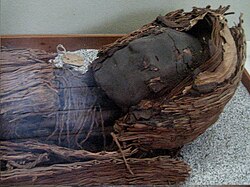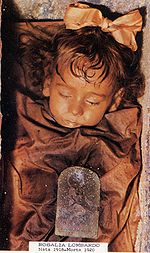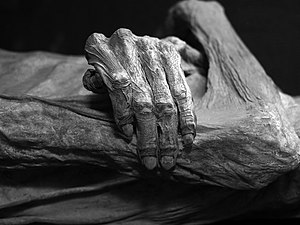Mummy
Mummies of humans and other animals have been found all around the world, both as a result of natural preservation through unusual conditions, and as cultural artifacts. Over one million animal mummies have been found in Egypt, many of which are cats.[1] The oldest known naturally mummified human corpse is a severed head dated as 6,000 years old, found in 1936 at the site named Inca Cueva No. 4 in South America.[2]
In addition to the well-known mummies of Ancient Egypt, deliberate mummification was a feature of several ancient cultures in areas of South America and Asia which have very dry climates. There are more than 1000 mummies in Xinjiang, China.[3] The oldest-known deliberate mummy is a child, one of the Chinchorro mummies found in the Camarones Valley, Chile, and dates from around 5050 BC.[4]
Etymology and meaning
| |||
| Mummy (sˁḥ) in hieroglyphs |
|---|
The OED defines a mummy as "the body of a human being or animal enbalmed (according to the ancient Egyptian or some analogous method) as a preparation for burial", citing sources from 1615 onwards, later than the first uses of other senses that include ground up mummy used as "a medicinal preparation", which dates to c. 1400.[7] However sense 3c: "A human or animal body desiccated by exposure to sun or air. Also applied to the frozen carcase of an animal imbedded in prehistoric ice", is cited to Chamber's Cyclopaedia, 1727–41, and the Victorian zoologist Francis Trevelyan Buckland.[8]
The Egyptian mummification process
The first evidence of intentional mummification in Egypt dates to 3500 B.C.[9] Parts of mummified human bodies recovered from Hierakonpolis exhibit evidence of resin and linen wrappings.[9]The earliest intact Egyptian mummy, ID #32751, dates to approximately 3400 BC, and is currently held in the British Museum.[10] Mummy 32751 was previously nicknamed "Ginger" for its hair color, but this practice was stopped in 2004, in order to afford more dignity to human remains. Mummy #32751 was an adult male; the exact age at death is uncertain. It was apparently preserved by direct contact with the dry desert sand, though it is uncertain whether the mummification was intended. Pottery vessels were recovered from the grave, but their significance is uncertain.[10]
From the Middle Kingdom onwards, embalmers used salts to remove moisture from the body. The salt-like substance found on the banks of salt lakes, natron, dried out and preserved more flesh than bone. Once dried, mummies were ritualistically anointed with oils and perfumes. The emptied body was then covered in natron, to speed up the process of dehydration and prevent decomposition. Natron dries the body up faster than desert sand, preserving the body more effectively. Often finger and toe protectors were placed over the mummy's fingers and toes to prevent breakage. They were wrapped with strips of white linen to protect the body from being damaged. After that, they were wrapped in a sheet of canvas to further protect them. Many sacred charms and amulets were placed in and around the mummy and the wrappings. This was intended to protect the mummy from harm and to give good luck to the Ka of the mummy. Once preserved, they were laid to rest in a sarcophagus inside a tomb, where it was believed that the mummy would rest eternally. The mummy's mouth would later be opened in an ritual designed to symbolize breathing, giving rise to legends about resurrected mummies.[11] In some cases, a mummy has been discovered in an unmolested tomb, only to be found in a state of advanced decomposition due to the proximity of the water table. This was the case with the discovery in 1998 of the mummy of Iufaa, an Egyptian priest and administer who lived around 500 BC.
The most famous Egyptian mummies are those of Seti I, Rameses II, and Tutankhamun (13th century BC).
Scientific study of Egyptian mummies
Mummies were much sought-after by museums worldwide in the 19th and early 20th centuries and many exhibit mummies today. Notably fine examples are exhibited at the Egyptian Museum in Cairo, at the Ägyptisches Museum in Berlin, and at the British Museum in London. The Egyptian city of Luxor is also home to a specialized Mummification Museum. The mummified remains of what turned out to be Rameses I ended up in a Daredevil Museum near Niagara Falls on the United States–Canada border; records indicate that it had been sold to a Canadian in 1860 and exhibited alongside displays such as a two-headed calf for nearly 140 years, until the Michael C. Carlos Museum in Atlanta, Georgia, which had acquired the mummy along with other artifacts, determined it to be royal and returned it to Egypt's Supreme Council of Antiquities. It is currently on display in the Luxor Museum.[citation needed]Modern scientific methods are being applied to mummies for archeological research. Mummies can be studied without the need to unwrap them using CAT scan and X-ray machines to form a digital image of the body. This has been very useful to biologists and anthropologists, providing a wealth of information about the health and life expectancy of ancient people. In 2008, the latest generation CT scanners (64- and 256-slice Philips machines at the University of Chicago) were used to study Meresamun, a temple singer and priestess at the Temple of Amun whose mummy now resides at the Oriental Institute of Chicago. Mummies have also been used in medicine to calibrate CAT scan machines at levels of radiation that would be too dangerous for living people.[citation needed]
Dr. Bob Brier of Long Island University has been the first modern scientist attempting to apply ancient Egyptian methods of mummification.[citation needed]
Post-interment care
Of special interest are finds that may testify to the beliefs of the ancient population of Egypt. In two Neolithic cemeteries, skulls were found that indicated tooth replacement in antiquity. In both cases, the teeth were apparently collected and repositioned by people during later burials. Also in the same cemetery, four bracelets were found encircling a right humerus, which had been moved from its original position, during the deposition of a later burial. However, the bracelets were maintained in place by the insertion of the individual’s own right ulna and radius that had been fractured post-mortem. Such manipulation suggests that the intention was to repair the damage caused during the insertion of later interments. These intentions are supported by the discoveries of two skulls with mis-positioned teeth. In one case, the right orbit contained eighteen of the individual’s teeth; in the other, the nasal aperture contained one tooth.[15]All of these examples suggest a deep conviction about the importance of body preservation, i.e., keeping the body together, ideally in an undisturbed state. Perhaps this was necessary to secure eternal life––similar to the belief that is so popular throughout all of ancient Egyptian civilization.[15]
Deliberate mummification in other cultures
Chinchorro Mummies
Inca Mummies
Italy
Natural mummification
Mummies that are formed as a result of naturally-occurring environmental conditions, such as extreme coldness (Ötzi the Iceman, the Ice Maiden, the Llullaillaco child mummies), acid (Tollund Man), salinity (Salt Man), or desiccating dryness (Tarim mummies), have been found all over the world. More than a thousand Iron Age corpses, so called bog bodies, have been found in bogs in northern Europe, such as the Yde Girl and the Lindow Man.[22] Natural mummification of other animal species also occurs; this is most common in species from shallow saline water environments, especially those with a body structure which is particularly favourable to this process, such as seahorses and starfish. Old mummies such as the dinosaurs Leonardo, Dakota, and the Trachodon mummy in America were very valuable discoveries.Asia
Czech Republic
Denmark
Mexico
Modern mummies
Commercial mummification
Article Source: http://en.wikipedia.org/
Article Source: http://en.wikipedia.org/
More Stories: http://blackboxmystery.blogspot.com/

![O34 [z] z](http://bits.wikimedia.org/w/extensions-1.20wmf1/wikihiero/img/hiero_O34.png)
![D36 [a] a](http://bits.wikimedia.org/w/extensions-1.20wmf1/wikihiero/img/hiero_D36.png)
![V28 [H] H](http://bits.wikimedia.org/w/extensions-1.20wmf1/wikihiero/img/hiero_V28.png)












No comments:
Post a Comment